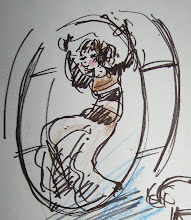I don't remember where I heard it, but somewhere along the line I picked up the tall tale that the trapeze started out as some kind of prop in places of ill repute, if you catch my drift. As much as I doubt the truthfulness behind that origin story, there's no denying that such tales are a part of the trapeze's history.
Ladies and gentlemen, for your viewing pleasure, strip trapeze circa 1901!
For those who are interested, this is what I found concerning the origin of the trapeze:
The slack rope was the first of the aerial acts. Through the iconography contained in newspaper advertising material we can date the American introduction of the single trapeze to the season of 1856. In that year, two circuses had such acts. Sands, Nathans & Co. had Denzer and Bliss; Flagg & Aymar featured Henry Harris. These men did acrobatics while hanging from the still bar. However, there is record of English performers hanging beneath hot air balloons as early as 1851. In a tented circus the still bar was usually suspended from a spar that jutted out from the center pole. Lacking the impetus provided by swinging, these artists treated the bar much as the horizontal bar was used in later years. As might be expected, their actions were overshadowed by the higher, swinging feats performed on the slack rope. Eventually, the trapeze came to be used as a swing itself. We first find it referred to as the "flying trapeze" in 1864 on the Tom King Circus. The origin of the flying trapeze, but not of its name, lies with Jules Leotard in Paris in 1859. Early trapezes were hung only fifteen feet from the ground. With the adoption of swinging they were suspended at ceiling height. It was then that the flying trapeze began to supplant standing riding as the favorite act of spectators. [Source]
Monday, April 9, 2012
Subscribe to:
Post Comments (Atom)


No comments:
Post a Comment